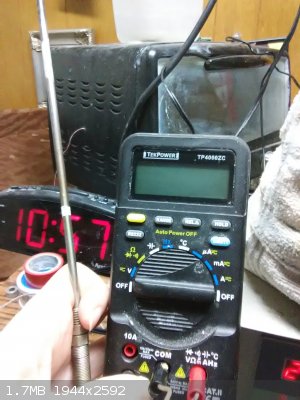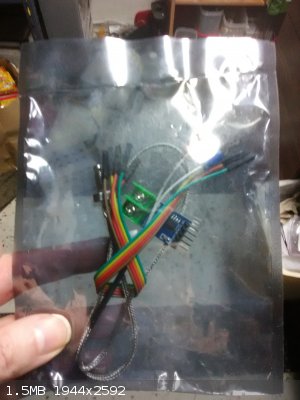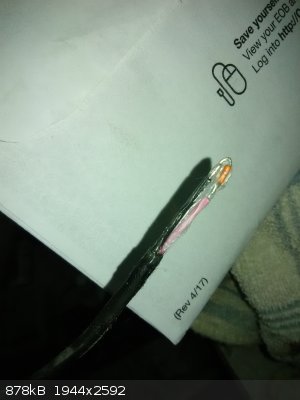NZniceguy
Harmless

Posts: 48
Registered: 16-9-2017
Member Is Offline
Mood: No Mood
|
|
85-2 chinese stirrer/hotplate replacement temp probe
I (stupidly) bought one of these off Aliexpress and it worked fine for the first month then the temp readings became erratic......I tracked it down to
the probe (resistance goes all over the place when tested).
The supplier wants $10usd for "postage" of the replacement but I'm sure I can just buy one cheaper and even get a couple for that price.
Does anyone happen to know what kind of probe it is or had a similar issue?
Would something along these lines work? Although that is a 3 wire probe and the one on the 85-2 is only 2 wire.
https://www.aliexpress.com/item/Steel-Temperature-Probe-Pt10...
|
|
|
JJay
International Hazard
    
Posts: 3440
Registered: 15-10-2015
Member Is Offline
|
|
It's hard to say for sure... the thermocouple on the 85-2 (I bought one too when I didn't know any better) should be replaced with the same kind of
thermocouple... $10 isn't a terrible price, especially seeing how the 85-2's thermocouple is insulated.
I would guess that it is a type K thermocouple, but I don't know for sure.
|
|
|
Sigmatropic
Hazard to Others
  
Posts: 307
Registered: 29-1-2017
Member Is Offline
Mood: No Mood
|
|
I've had a similar issue where the iron-constantan thermocouple on an IKAMAG had stopped working because the iron wire had been completely rusted over
the years to the point where it broke and disrupted the circuit. I simply stripped the wires a bit further back, wrapped them together and embedded
them in the plate with some gypsum. These thermocouples are not very complicated and you really don't need to buy a replacement when you can restore
the contact
|
|
|
NZniceguy
Harmless

Posts: 48
Registered: 16-9-2017
Member Is Offline
Mood: No Mood
|
|
Quote: Originally posted by JJay  | It's hard to say for sure... the thermocouple on the 85-2 (I bought one too when I didn't know any better) should be replaced with the same kind of
thermocouple... $10 isn't a terrible price, especially seeing how the 85-2's thermocouple is insulated.
I would guess that it is a type K thermocouple, but I don't know for sure. |
I tried a type K and the temperature was way out eg reading 60c at room temp
I just know that i'm paying for a replacement that they are saying is free and I also know that they get subsidised shipping so there's no way it
would cost us$10 to post to NZ. Guess I might just have to suck it in and pay the ransom.
|
|
|
NZniceguy
Harmless

Posts: 48
Registered: 16-9-2017
Member Is Offline
Mood: No Mood
|
|
Quote: Originally posted by Sigmatropic  | | I've had a similar issue where the iron-constantan thermocouple on an IKAMAG had stopped working because the iron wire had been completely rusted over
the years to the point where it broke and disrupted the circuit. I simply stripped the wires a bit further back, wrapped them together and embedded
them in the plate with some gypsum. These thermocouples are not very complicated and you really don't need to buy a replacement when you can restore
the contact |
The wires are well stuck down in the probe so I cant pull them out to look at what is wrog without snapping them off unfortunately.
|
|
|
semiconductive
Hazard to Others
  
Posts: 287
Registered: 12-2-2017
Location: Scappoose Oregon, USA.
Member Is Offline
Mood: Explorative
|
|
The 85-2 that I have uses a silicon diode as a temperature sensor. You can't use a normal thermocouple or thermistor to replace a diode. The
resistance of the diode is actually irrelevant, as a diode regulates its voltage based on temperature and the resistance is dynamic.
I took mine apart, and It just looks like a typical glass passivated 1N4448 or equivalent diode to me. I haven't tested it directly, but chances are
good that a 1N4148, or 1N4448 diode from Radio Shack would work as a replacement. If you use the wrong diode, the temperature scale will be off a
little bit ( a few degrees one way or the other ).
Silicon diodes are only rated to a little over 125Celsius (sometimes 150C). So, if you accidentally overheat it beyond that it's quite possible to
destroy the diode.
I bought the 85-2 for the body and not the electronics. As an EE, rebuilding the thing to be controlled by my own electronics is simple; but it's not
a very good general purpose controller for use in the USA ... it's really designed to be operated from 220VAC, not 110 to 125VAC.
Even when heating a sulfuric acid flask, The 85-2's top temperature at 115VAC is only around 150Celsius. Higher temps require insulation to be added
to a mid sized 500Ml Earlenmeyer flask with only 200mL of H2SO4 in it. (The Probe that comes with the 85-2 can't be used because the top regulator
temperature is only 100C, so I set the temperature probe set off to the side to get hotter temps because it "thinks" the object is at 24C. )
[Edited on 23-1-2018 by semiconductive]
|
|
|
NZniceguy
Harmless

Posts: 48
Registered: 16-9-2017
Member Is Offline
Mood: No Mood
|
|
Oh ok, that makes sense, I was running it at max on 240v ac up at 320c doing a Niacin decarboxylation so it was a little bit avove 150c 
So It should show minimal resistance in one direction only if tested with a multimeter?
How did you get the diode out of the probe? I've unscrewed the plastic bit at top and pulled the cord as hard as I feel comfortable doing so to no
avail.
Could I ust put a 1n4148 or similar in a glass tube sealed at the bottom do you think?
I am capable of wiring up athird party temp controller but what would you suggest for a probe? I have a few of those K type thermocouples around.
I also bought a pid controller but it too only goes up to 100 degrees C.
|
|
|
semiconductive
Hazard to Others
  
Posts: 287
Registered: 12-2-2017
Location: Scappoose Oregon, USA.
Member Is Offline
Mood: Explorative
|
|
if the diode is ruined, you will can get resistance in both directions using ohms on a multimeter. But, yes, in general a diode will still measure
with different resistances depending on which direction you hook the probes up. Note: Multimeter Diode check settings tend to measure voltage across
the diode at a fixed current rather than resistance in ohms. Eg: typcially it's in millivolts. That's usually a better test. It shoud measure
between 500 and 900 mV.
My diode just came out of the probe with no problem. I don't know if they sometimes use glue or not. It could be a simple cheap manufacturer failure
that allows mine out, and yours not.
My diode began acting erratically, and when I removed it I realized there was moisture that had gotten into the open end of the stainless probe and
wetted the diode. Diodes are *VERY* sensitive to leakage current caused by moisture. My solution was to just coat it in silicone after drying it.
It works perfectly, again. Stainless probes are also pretty useless for measuring 90+% sulfuric acid as it's eaten. My thought was to make a sealed
glass thermocouple, just like you appear to be thinking. However, once I realized it was a diode ... I knew that I couldn't melt glass to make it
air-tight. About the best that can be done for a diode is a glass thermometer condom embedded in a ground glass stopper.
I 'll shoot a picture in the morning of my setup.
Note on PID temperature control: I took a toaster oven, replaced the walls with alumina cement (a heavy mistake... plaster would have sufficed I
learned later); and I programmed an SCR to turn on and off using an RS232 cable. So, I just bought a couple of USB to RS232 dongles (FTDI232 similar,
but better) and a raspberry PI to control it. There's an RS232 multimeter available with K-thermocouple measurement capability built in that I
bought for $20. So, that's how I measured the oven's temperature.
The issue with PID algorithms is that the thermal delay is very large and I was forced to programming several safety lockouts into my PI to prevent
heat oscillations. The loop has to run very slowly. With the oven, I was able to control it up to 400C using the built in elements, and about 300C
using one of those radient heater stove-top replacements. But neither heating element was satisfactory.
The software in the rasperry PI is just written in Python, so it's not big deal to share it.
For the stuff I want to do, though, it's not a good solution. Dual loop control would be much better, along with Blue-tooth connectivity so it can be
run from a cell-phone or talk to a generic PC or MAC. There's a more comprehensive solution that I've been developing, but won't really be able to
finish until this summer/fall. It's not an amateur project, because there are UL listing hazards in the design unless it's built in a certain way
that aren't easy to buy off the shelf. It's a legal hazard to show people how to build it. Also, the development tool for the bluetooth chip I want
to use is having trouble under Linux; although I will be able to solve that, it's a matter of time before all these pieces come together.
See. Dr. Bob's thread, as I'm enquiring about amateur's needs for a temperature controller and he discusses the ugly price issues for stuff currently
on the market:
https://www.sciencemadness.org/whisper/viewthread.php?tid=18...
[Edited on 24-1-2018 by semiconductive]
|
|
|
semiconductive
Hazard to Others
  
Posts: 287
Registered: 12-2-2017
Location: Scappoose Oregon, USA.
Member Is Offline
Mood: Explorative
|
|
From right to left;
The tech-power TPZ4000ZC multimeter with thermocouple probe and RS232. The oven I talked about is in the background. I drilled a hole in the top to
let the stainless probe slide in to measure temperature. This can be made to work directly with a PC, laptop, linux, or a raspberry PI by purchasing
an RS232 dongle. I don't suggest FDTI brand, but rather a chineese knockoff with a different chipset number... both dongle's are buggy, but the
chineese knockoff has higher output voltage which corresponds to the RS232C spec whereas the american FTDI does only 5V output. The library I wrote
in python overcomes the bugs, and I reverse engineered the tech-power RS232 protocol, so that it can be read from a normal python library and doesn't
require proprietary software.
Second picture: An $5 ebay-china purchase for Adruino, it's a K type themocouple with an interface board meant to to go to an embedded controller;
eg: an adruino. However the probe can be wired up to any microprocessor, or even a raspberry pi. I plan on using this to test the chipset out on the
circuit board, and then modify it to run a copper-constantin probe that has been sealed in glass. Glass melting against the metal will change the
voltage profile slightly, so I will have to calibrate the probes against a platinum RTD; but once built they will be immune to most chemical attacks
and interfaceable to a normal PC or raspberry PI over bluetooth or an optically isolated cable. That will protect the computer from damage due to
broken glass probes in wet chemicals, in case someone abuses the probe.
Third picture, the diode on the end of the 85-2 cable that was inside the stainless probe when I bought it. I removed a little bit of the heat shrink
tubing, and then coated it in silicone to prevent moisture from getting to it. It now works perfectly.
Fourth picture, a typical glass themometer adapter with glass sleeve (condom.) This is about the best that can be done for a diode. Or, I suppose if
you have a small test-tube, you could use that to keep the diode from coming into contact with chemicals.
   
|
|
|